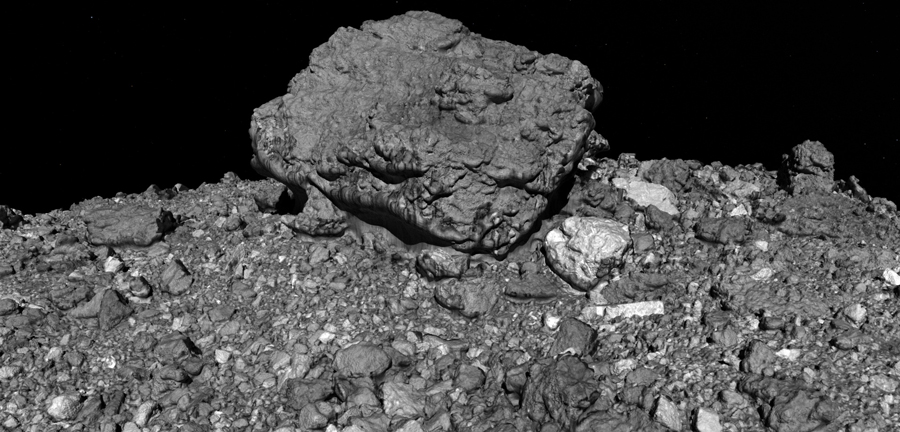C -Type, near Earth asteroids Ryugu and Bennu have been the subjects of recent robotic sampling missions. These missions have yielded valuable data relevant to the formation of the solar system and have important implications for the future of deep-space commerce.
The asteroid designated “162173 Ryugu” is an Earth-crossing, 865-meter diameter, carbonaceous asteroid rich in carbon, organics and metals. Japan’s Hayabusa2 completed its mapping and sampling of Ryugu on July 11, 2019 and successfully returned the samples to Earth on Dec. 6, 2020.
Hayabusa2 also deployed four tiny rovers and fired a projectile at the asteroid’s surface to expose pristine material.
Hayabusa2’s instruments revealed that Ryugu is one of the darkest bodies in the solar system and that its carbon content might be higher than 2 percent.
C-type asteroids are the likely parent bodies of carbonaceous chondrite meteorites. These are the building blocks of life from the primordial interstellar dust cloud that formed our solar system. C-type asteroids not only contain organic molecules, their spectra indicate that they also contain hydrated minerals.
The asteroid 101955 Bennu is an Earth-crossing, potentially hazardous asteroid, or “PHA.” Bennu is a 492-meter diameter, C-type asteroid rich in carbon, organics, and metals, similar to Ryugu. It is estimated to have a one in 1,800 chance of impacting Earth in 2182. Close scrutiny and continued analysis will help refine Bennu’s orbit predictions. Solar heating as an asteroid rotates can subtly change its orbit, due to the Yarkovsky effect, which is a force acting on a rotating body in space caused by the anisotropic emission of thermal photons carrying momentum. So, there is potential for Bennu’s orbital trajectory to be altered over the next 160 years.
NASA’s OSIRIS REx probe successfully completed mapping and sampling asteroid Bennu on Oct. 20, 2020, with sample return to Earth scheduled for Sept. 24, 2023. Labs at NASA’s Johnson Space Center and Japan’s JAXA Extraterrestrial Sample Curation Center eagerly await the pristine asteroid samples for detailed study.
Findings Thus Far
Bennu and Ryugu are rubble pile asteroids with similar top shapes. They might have formed by re-aggregating from the same disrupted parent asteroid body. Investigators were amazed at the size of the rubble and found it difficult to find areas smooth enough to touch down for sampling.
“We found six boulders ranging in size from about 1.5 to 4.3 meters scattered across Bennu’s southern hemisphere and near the equator,” said Daniella DellaGiustina, NASA image processing lead scientist.
“These boulders are much brighter than the rest of Bennu and match material from Vesta,” she said, referring to asteroid 4 Vesta, which is the second most massive body in the main asteroid belt.
“Our leading hypothesis is that Bennu inherited this material from its parent asteroid after a fragment from Vesta struck the parent,” said Hannah Kaplan of NASA’s Goddard Space Flight Center in Greenbelt, Md. “Then, when the parent asteroid was catastrophically disrupted, a portion of its debris accumulated under its own gravity into Bennu, including some of the pyroxene from Vesta.”
OSIRIS REx remote sensing of Bennu has revealed water locked inside clays. OSIRIS REx uses two spectrometers: OSIRIS-REx visible and infrared spectrometer and OSIRIS-REx thermal emission spectrometer. Hydroxyl (OH) exists across the asteroid in water-bearing clay minerals. OSIRIS REx study of Bennu focuses on the composition of primitive volatiles and organics which help reveal the history and evolution of the solar system. Spectrometer near-infrared absorption on Bennu near 2.7 micrometers is most similar to aqueously altered CM-type carbonaceous chondrite meteorites.
The Murchison meteorite, which fell in Australia in 1969, is the most well-known and studied CM2 carbonaceous chondrite. In bulk, it contains iron, nickel, silicon, aluminum, chromium and 12 percent water. It is also rich in organics, such as amino acids, aromatic hydrocarbons, purines and pyrimidines and ribose sugar.
From Hayabusa 2 remote sensing, the water signature seen on Ryugu today is all that remains of a potentially more water-rich parent asteroid that dried out due a heating event. Hayabusa2 released an impactor that exposed subsurface rock with a dried-out surface. It is still plausible that Ryugu and Bennu formed from the same parent but went through different subsequent histories.
Mining for Space Oil (a.k.a., Water)
In other news of exploring asteroids of our solar system, NASA just launched the robotic Lucy Mission to explore Trojan asteroids near the L4 and L5 Lagrange points of Jupiter’s orbit. After gravity assists from Earth, Lucy will encounter and study a main-belt asteroid in 2025 and eight trojan asteroids from 2027 to 2033.
From measured spectra, the Jupiter trojans mostly are D-type asteroids, common in the outer regions of the asteroid belt. They have a very low albedo and a reddish spectrum with an assumed composition of organic-rich silicates, carbon, and anhydrous silicates, possibly with water ice in their interiors. As such, they are similar to C-type asteroids like Bennu and Ryugu.
“The Trojan asteroids are leftovers from the early days of our solar system, effectively the fossils of planet formation,” said Lucy mission principal investigator Harold Levison of the Southwest Research Institute.
For us as resource explorers, the C and D-type asteroids have implications for future deep space commerce. The primary driver is water, the deep space resource analog of oil on Earth – simple and valuable! Astronauts and settlers will need water to drink. Electrolysis of water yields oxygen and hydrogen. Oxygen is obviously valuable to breathe and both oxygen and hydrogen are valuable rocket propellants.
It currently costs up to $35,000 per kilogram to lift water or propellant from Earth to space with expendable rockets, or $1,800 per kilogram with reusable rockets. Water, as a resource produced from C and D-type asteroids, will have a high value in tomorrow’s arena of interplanetary commerce. Asteroid Bennu contains about 8 million cubic meters of water that could be worth trillions of dollars in a deep space economy.
